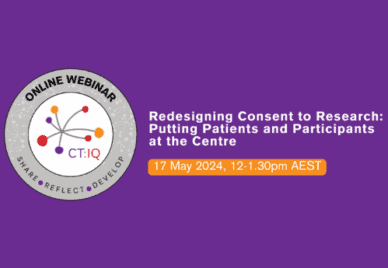
Redesigning Consent to Research: Putting Patients and Participants at the Centre
Go to partner eventabout Redesigning Consent to Research: Putting Patients and Participants at the Centre
A group of researchers in Australia have been studying the complexities of drug interactions and behaviours, which could lead to transformational changes in pharmaceutical drug design.
High-level computing is a key to their work.
“It allows us to make complex calculations from images captured by cryo-electron microscopy and to see how drugs bind,” said Patrick Sexton, Professor at the Monash Institute of Pharmaceutical Science. He leads the ARC Training Centre for Cryo-Electron Microscopy of Membrane Proteins for Drug Discovery.
“Arguably, we are the world’s leading lab in the work we do.”
According to Patrick, access to high levels of computational power lets the researchers visualise a snapshot of how drugs bind while also gaining a better understanding of the underlying dynamic processes associated with drug binding. It also allows them to get results quicker and have better control over the research process.
“Having the computational power allows us to see how drugs behave,” Sexton said.
The Australian Research Data Commons’-supported Characterisation Virtual Laboratory (CVL) has played an important role in running and managing the group’s data-intense programs. It created the software environment to run high-powered electron microscopy, CryoEM, and managed data ingestion, archiving and long term storage.
It also provided a user-friendly remote desktop, which is linked to the university’s powerful MASSIVE supercomputer.
The world-leading lab group uses CryoEM and supercomputers to create detailed images of cell surface receptors, which are integral to understanding how many medications work.
For example, there are approximately 800 different types of G protein-coupled receptors. Around a quarter of all medications interact with these cell surface receptors, yet only a small fraction are currently used as drug targets.
Sexton and colleagues are currently studying around twenty different types of G protein-coupled receptors and the roles they play in diseases such as diabetes, obesity and cardiovascular disease.
Their work offers the potential to develop drugs that selectively target beneficial pathways and avoid those that can lead to negative side effects.
Patrick said that traditional views and knowledge about how drugs work is changing, often due to a previous lack of mechanistic understanding of the way the drugs work.
“Yes, we could get drugs to market but we were not necessarily predicting therapeutic effects in the way that we potentially could, and we were not directing the drugs to particular therapeutic end points as well as we could,” he said.
The group’s research and increased knowledge about drug interactions aims to result in more effective, targeted medicines with reduced negative side effects.
This includes better treatments for a range of diseases including schizophrenia, Alzheimer’s, and type-2 diabetes.
The drug design research continues under the ARDC-supported Australian Characterisation Commons at Scale.